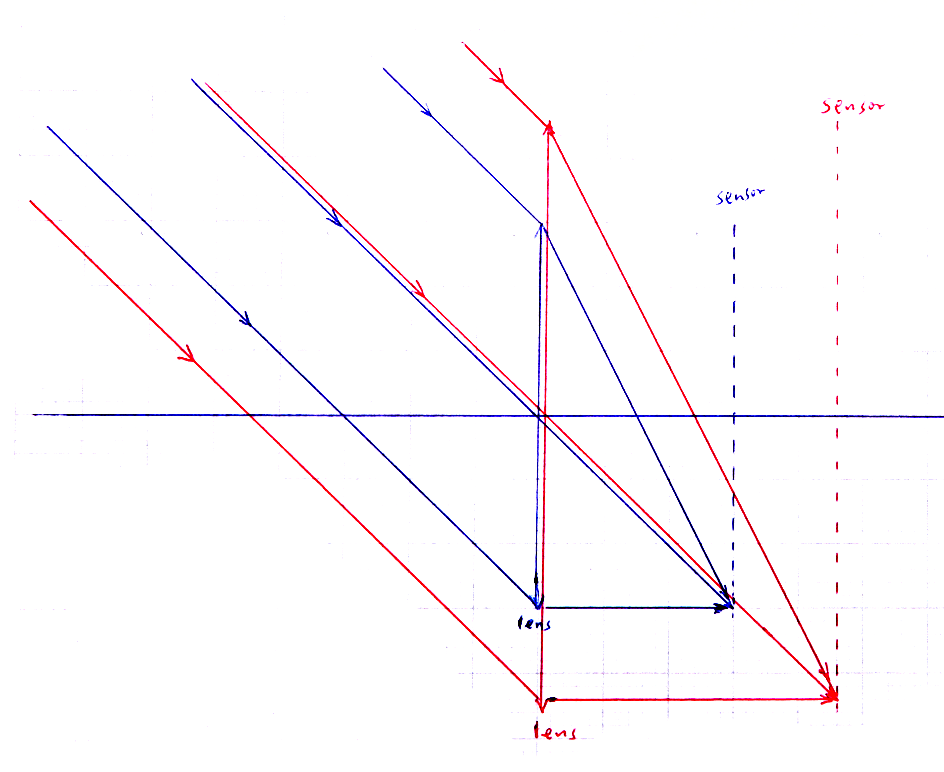To support 1234567\'s proposal, let me write the following short article on sensor-related vignetting.
1. Introduction
This topic has been discussed at least twice without any conclusion. I hope this article would put this subject to rest.
2. Scope of this study
We are only interested in vignetting introduced by the reflection by the photo sensors, and uninterested in lens-related (including lens mount) vignetting.
3. The problem
When a surface reflects light, the reflectivity (percentage being reflected) is dependent on the incident angle. For example, when you look through a glass perpendicularly (incident angle=0), you see very little reflection (assuming both sides of the glass have more or less the same brightness). But when you look through the glass at large incident angle (looking through at almost parallel to the glass surface), the glass is almost like a mirror, that is, a lot of energy is reflected.
Same thing happens with digital sensors. When light hits the edge of the sensor, the incident angle is large compared with the center of the sensor -> more light is reflected -> less light is detected by the sensor -> sensor related vignetting.
The problem under study is: When taking the same photo (that is, standing at the same point, taking photos that look exactly the same), does the sensor related vignetting depends on the sensor size? Note, to take the same photo (that is, same field of view), a camera with a small sensor will use a lens with shorter focal length. For example, if a full frame camera takes a photo with a 45mm lens, on a 1.5x crop camera, it will need a 30mm lens.
4. Some basics
4.1 In most photographic applications, the object is located far away (related to the dimension of the camera). So we can consider the object is located at infinity, so that light rays coming from a particular point of the object is parallel by the time they reach the lens.
4.2 Under the assumption of 4.1, the image will be located at the focal plane of the lens.
4.3 Aperture value (aka f-#, f-stop) is defined as: f/D, where f is the focal length of the lens, and D is the diameter of the lens.
5. Ray diagram
The following diagram describes the imaging process of two cameras. The blue lines are for a 1.5x crop camera (roughly to scale), and the red lines are for a full frame camera. The object is located on the left side of the lenses.
Note 1. Light rays entering the lenses are parallel (see 4.1)
Note 2. Light rays are focused on the sensors (see 4.2).
Note 3. The diameter of the full frame camera is 1.5 time as large as the crop lens for the same f-# (see 4.3).
6. Conclusion
Please note that the angles at which light rays strike the two sensors are exactly the same, regardless the sensor size. That is, the amount of light being reflected is the same -> sensor-related vignetting is the same.
7. Off topic
Some have pointed out that full frame cameras (such as D3 on dpreview) have more vignetting. The cause is: the lens! To keep optical properties the same, a full frame lens must be (for Nikon) 1.5^3=3.4 times as large. To save weight (and cost), lens makers literally cut corners.
Some have also pointed out another possible cause for the D3 vignetting: the Nikon lens mount is too small, so that it blocks some light heading towards the edges and corners of the full frame sensor. This is definitely possible. But the point here is: this would be classified as lens related vignetting.
8. The end
Thanks for reading.
Sensor vignetting: does it depend on sensor size?
登录后才可评论.